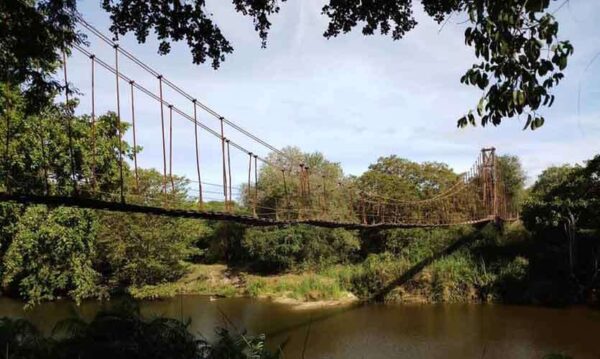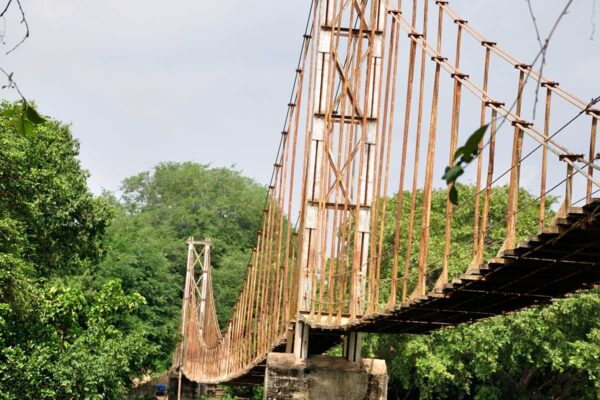Kunchikulam Suspension Bridge – rare structure in the wilderness – By Arundathie Abeysinghe

 Situated approximately 42 kilometers from Mannar along Medawachchiya -Talaimannar road in Kunchikulam, in close proximity to *Wilpattu National Park, Kunchikulam Suspension Bridge is a hidden tourist attraction in the wilderness. Also known as “Kunchukulam Suspension Bridge”, Kunchikulam Hanging Bridge or “Kunchikulam Ellena Palama” or “Kunchikulam Sangili Palama” (in Sinhala meaning suspension bridge), the 100 meter long and 1.2 meters wide bridge is held by two strong cables with steel sheets laid across. The Bridge stretches across Malwathu Oya (Oya meaning stream in Sinhala). The Bridge can be seen en route to popular *Madhu Church when traveling from Medawachchiya. There is a small bill board before this road with directions to the hanging bridge.
Situated approximately 42 kilometers from Mannar along Medawachchiya -Talaimannar road in Kunchikulam, in close proximity to *Wilpattu National Park, Kunchikulam Suspension Bridge is a hidden tourist attraction in the wilderness. Also known as “Kunchukulam Suspension Bridge”, Kunchikulam Hanging Bridge or “Kunchikulam Ellena Palama” or “Kunchikulam Sangili Palama” (in Sinhala meaning suspension bridge), the 100 meter long and 1.2 meters wide bridge is held by two strong cables with steel sheets laid across. The Bridge stretches across Malwathu Oya (Oya meaning stream in Sinhala). The Bridge can be seen en route to popular *Madhu Church when traveling from Medawachchiya. There is a small bill board before this road with directions to the hanging bridge.
After traveling approximately 800 meters on this road, there is an ancient Steel Arch Bridge constructed across Yoda Ela, a 13 kilometer long canal built by King Dhatusena (459-477) which diverts water from Malwathu Oya and feeds Yoda Wewa.
This spectacular Suspension Bridge is a tourist attraction for visitors traveling to Mannar, some exploring other tourist attractions such as Mannar Island, Thanthirimale and *Baobab Tree and some pilgrims visiting Madhu Church. But for locals, this is the only mode of transport during the rainy season.
Constructed in 1935 to cross Aru viaaru in Kunchikulam, the Suspension Bridge is a spectacular steel structure.
According to locals, the old pedestrian hanging bridge in the midst of a jungle trail is the only means of crossing the stream flowing below, especially during the heavy monsoonal floods. Although, there is a motorable causeway bridge several meters away, it is situated at a lower level than the Suspension Bridge and it gets inundated during the rainy season. The floor of the bridge is laid with steel sheets on short wooden beams and some wooden planks seem to have decayed and in certain places, these planks are sloped towards the river. Hence, walking across the Bridge is risky, although villagers walk across it during the rainy season.
A new concrete bridge as well as a “Sapaththu Palama” (Causeway) has been constructed across Malwathu Oya below the Suspension Bridge, making the hanging bridge redundant.
Unknown to the majority, Kunchikulam is a fascinating place. During day time, streets of Kunchikulam are filled with local people going about their day to day life; going to school, collecting water, visiting neighbours and grazing their goats. By night, the streets are taken over by wild elephants, looking for fruits such as banana or wood apple to feast on.

Travel Directions: From Colombo travel up to Mannar and thereafter, head southeast from Mannar along St. Sebastian’s Road. Travel approximately 42 kilometers along Medawachchiya-Talaimannar road to reach Kunchikulam Suspension Bridge situated in Kunchikulam.
Image courtesy – attractionsinsrilanka.com & life.lk
Baobab Tree – iconic landmark in Mannar
By Arundathie Abeysinghe
https://www.elanka.com.au/baobab-tree-iconic-landmark-in-mannar-by-arundathie-abeysinghe/
- Madhu Church – Popularly known as Madu Church, the Shrine of Our Lady of Madhu also known as “Our Lady of The Rosary of Madhu” is a Roman Catholic shrine in Mannar. With a history of over 400 years, this shrine is a center for pilgrimage and worship of Sri Lankan Catholics. The Church is one of the few churches visited by Buddhists as well as Hindus from all over the country. The Madhu Festival was originally held on 2nd July. At present, 10 festivals are held annually. The most popular festival is held on 15th August which draws thousands of visitors from all over the country, Catholics as well as Buddhists and Hindus.
- Mannar – Situated in the Northern Province of Sri Lanka, Mannar consists of an area which is part of the mainland as well as Mannar Island, the largest islet in the country. Situated in the Dry Zone of Sri Lanka, the landscape of Mannar is varied; wooded jungles to paddy fields and palm trees. According to legends, Mannar Island had served as a connection to the southern tip of India, in the past.
- Wilpattu National Park – A national park in Sri Lanka bounded by the Moderagam Aru and Kala Oya in the north and south and by Portugal Bay, and the northernmost reaches of the Kalpitiya peninsula and Karativu island. The unique feature of Wilpattu National Park is the existence of “Willus” (natural lakes), natural sand-rimmed water basins or depressions that fill with rainwater. Located on the northwest coast lowland dry zone of Sri Lanka, the Park is 30 kilometers west of Anuradhapura and 26 kilometers north of Puttalam and approximately 180 kilometers north of Colombo. Wilpattu National Park is the best location for leopards, sloth bears, birds and a variety of wildlife sightings in Sri Lanka.







